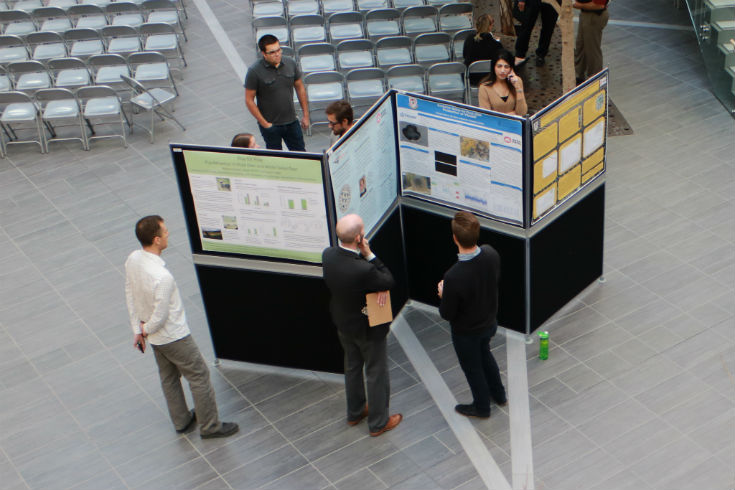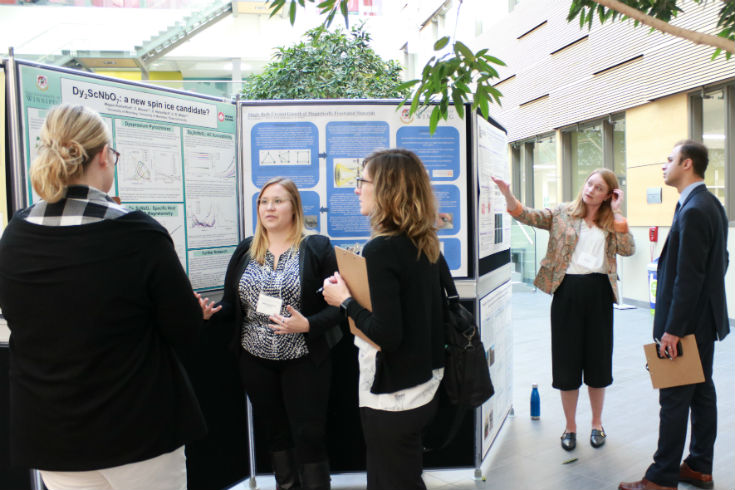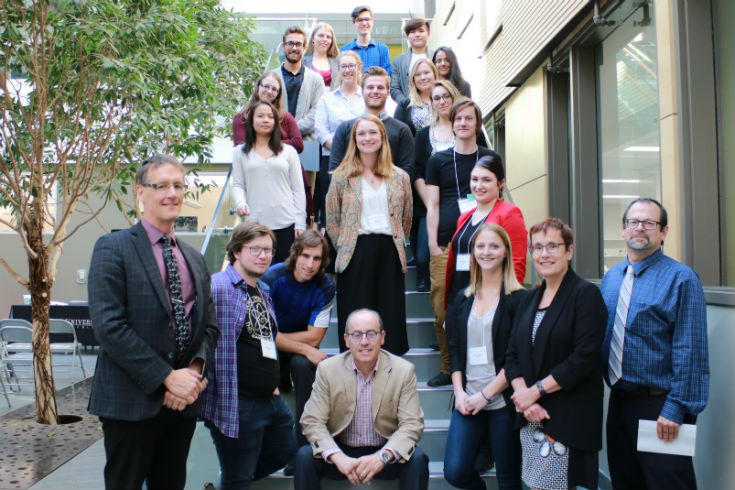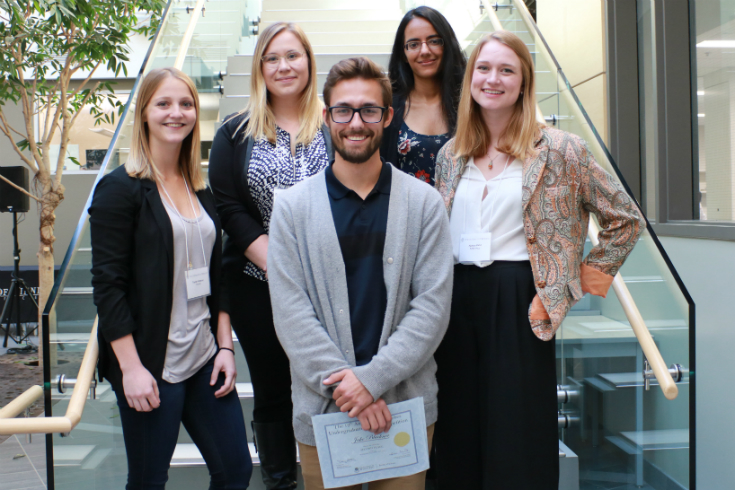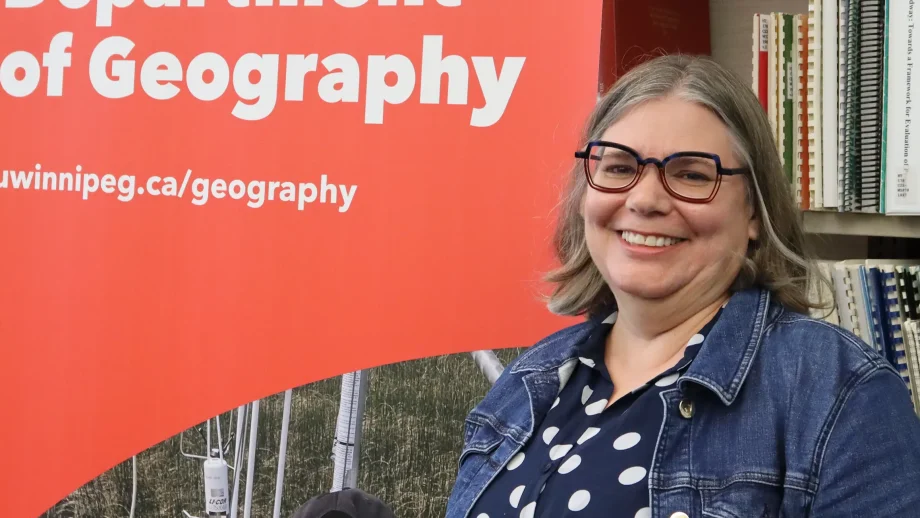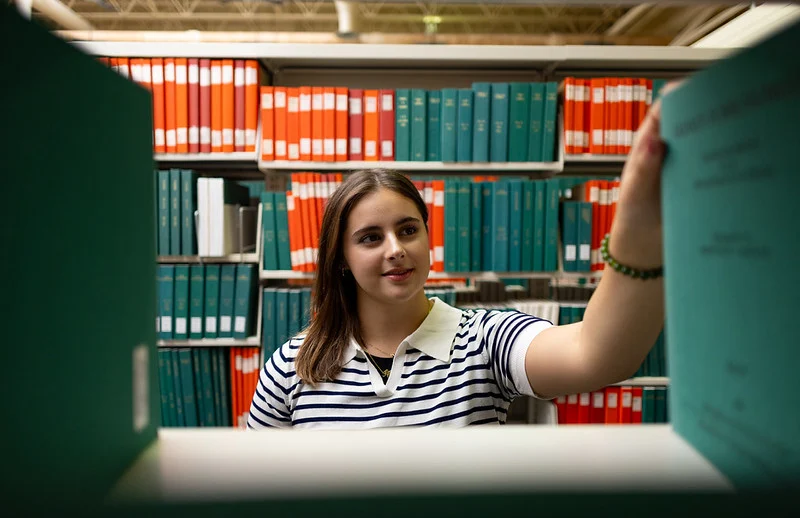The 12th annual Randy Kobes Undergraduate Science Poster Contest saw 20 participants from a wide range of disciplines present their research at the contest on Wednesday, September 20 at the Richardson College for the Environment and Science Complex. The yearly poster contest displays high quality research by undergraduate students at The University of Winnipeg. The event is a valuable opportunity for students to obtain experience in presentations of scientific research, which one professor described as: UWinnipeg’s defining events regarding undergraduate research and participation.
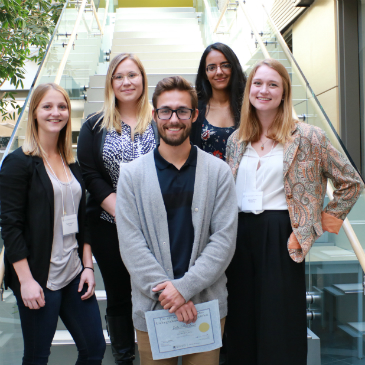
The winners, Taylor Hanson, Megan Rutherford, Jake Blackner, Navjot Kaur and Alyssa Kidd, ©UWinnipeg
“The students who shared their research today showcased an amazing range of talent,” said Dr. Jino Distasio, UWinnipeg Vice-President, Research and Innovation.”I remain impressed by the breadth and scope of these important contributions.”
This year’s top prize went to Megan Rutherford, for her research on Dy2ScNbO7: a new spin ice candidate, (Supervisor: Dr. Chris Wiebe, chemistry).
Second place was tied between three researchers: Navjot Kaur for Lead α-glucosidase inhibitors from Sapium integerrimum, (Supervisor: Dr. Athar Ata, chemistry); Jake Blackner for Ferrocenium Boronic Acid Catalysed Coupling of Alcohols with Borate and Silane Nucleophiles, (Supervisor: Dr. Adam McCubbin, chemistry); and Taylor Hanson for Auto Image Review for Intact Prostate Radiation Therapy Patient, (Supervisor: Dr. Ryan Rivest, physics).
Third place was also a tie between Rebecca Carter for Play for Prey: Play Behaviour in Mule Deer and White-Tailed Deer, (Supervisor: Dr. Susan Lingle, biology); and Alyssa Kidd for I Got It from My Mama (?): Fetal Programming, Gestational Diabetes, and Incretin Hormone GLP-1, (Supervisor: Dr. Danielle Defries, kinesiology).
UWinnipeg would like to thank the judges who volunteered their time: Jennifer Cleary – Program Officer, Research Development, Office of VP Research & Innovation, UWinnipeg; Jill Condra – Program Officer Research Partnerships, Office of VP Research & Innovation, UWinnipeg; Rebecca Danos – Research Scholar; Kerrie Hayes – Director, Research Contracts, University of Manitoba; Marilyn Johnstone –Treasury Board Secretariat, Government of Manitoba; Sarah Kobes – UWinnipeg Alumni; Landon Mah – Senior Business Officer, Operations, Western Economic Diversification Canada; Tricia Meaud – Research Partnership Promotions Officer, Prairies Regional Office, NSERC; Stephen Szczerba – Business Development Manager, Life Sciences, Government of Manitoba; Iman Yahyaie – Director of Business Development, Mitacs.
We gratefully acknowledge sponsorship from The University of Winnipeg Dean of Science Office.
The student researchers and supervisors
Hamza Amjad ~ Don’t just blame the cows! A global synthesis of rates of methane ebullition from aquatic sediments
Supervisor: Dr. Nora Casson, biology
Abstract: A large proportion of methane produced in aquatic ecosystems originate in the sediments. Much of this methane makes its way to the surface via bubbles (ebullition), the rates of which vary considerably in space and time. In this study, we performed a literature review a) to quantify rates of ebullition from water bodies across the globe and b) to examine patterns and drivers of variability in rates of ebullition. Ebullition rates were higher in summers, at shallower depths and in areas with abundant vegetation. This is an important, but understudied flux in aquatic greenhouse gas budgets and more measurements are needed, particularly from systems that have been altered by human activity.
Hunter Davis ~ What’s the buzz? How fruit flies provide insight into the mechanisms of speciation
Supervisor: Dr. Alberto Civetta, biology
Abstract: We recently discovered two subspecies of Drosophila willistoni (fruit flies) that display hybrid male sterility when mated. Here we show an unprecedented mechanism of sterility driven by the male’s inability to transfer sperm due to a gonadal atrophy. Hybrid male sterility is an important barrier to reproduction in the process of speciation
Samantha Taylor ~ 2D Model of Black Hole Formation
Supervisor: Dr. Gabor Kunstatter, physics
Abstract: Black holes are a theoretical phenomenon that cannot be seen directly and form when massive stars collapse after all their nuclear energy has been exhausted. The focus of this project is using computer code to study a 2D model of the formation of a black hole and the evolution of its properties.
Angela Concepcion ~ Influence of Freezing and Cold Temperatures on Phosphorus Release from Manitoba Soils under Flooded Conditions
Supervisor: Dr. Darshani Kumaragamage, environmental studies and sciences
Abstract: The effects of freezing and cold temperatures on phosphorus (P) dynamics under flooded, anaerobic conditions were investigated using alkaline soils. Dissolved reactive P concentration in floodwater increased with time of flooding, but the magnitude of increase was significantly less when flooded at +4°C than at +20°C.
Darren Dujlovic ~ Limb segment dimensions and volume using low-cost, structured-light 3D scanners
Supervisor: Dr. Robert Pryce, kinesiology
Abstract: The purpose of this study was to determine the accuracy and reliability of a new, low-cost 3D-scanner for assessment of human limb dimensions and volumes, compared to manual measurements and water displacement. Accuracy was -1.8±4.1% and 3.9±4.1% for inert objects (n=24) and human limbs (n=27), respectively (ICC > .97).
Carolyn Gregory ~ Comparison of Phosphorus Release to Pore Water and Floodwater from Manitoba Soils under Simulated Spring Snowmelt and Simulated Summer Flooding Conditions
Supervisor: Dr. Doug Goltz, chemistry
Abstract: Phosphorus is routinely added to farmlands to promote crop production, but is mobilised into water during prolonged flooding, contributing to lake pollution. Eight Manitoba soils were contrasted under two temperature conditions to observe how the cold temperatures in spring snowmelt affect this phenomena.
Kelsey Duncan ~ Single Bulk Crystal Growth of Magnetically Frustrated Materials
Supervisor: Dr. Chris Wiebe, chemistry
Abstract: Crystals are known to be a very attractive media to study as they offer unique advantages over generic solid or powder samples. They give us a clearer insight into the geometry of the compound and, when produced in lab, are typically highly pure samples. Though very useful, growing crystals, especially bulk single crystals, can be very tricky. My poster will showcase the synthesis by crystal growth of three different magnetically frustrated materials and explore why, these and like samples are so integral to the discovery and characterization of new magnetic materials.
Megan Rutherford ~ Dy2ScNbO7: a new spin ice candidate?
Supervisor: Dr. Chris Wiebe, chemistry
Abstract: The study of quantum materials is concerned with the behavior of compounds that do not obey the classical laws of physics. One such of these strange materials is Dy2ScNbO7, a newly synthesized compound that adopts the well known pyrochlore structure. Attempts to grow single crystals of Dy2ScNbO7 have been successful using the floating zone image furnace. Recent characterization results will be presented.
Jeremy Leathers ~ The Effect of Freeze/Thaw Cycles on the Release of Nutrients from Riparian Vegetation in Southern Manitoba
Supervisor: Dr. Nora Casson, biology
Abstract: Riparian vegetation such as cattails (Typha spp.) are often used to intercept and take up nutrients from runoff in order to limit nutrient loading and eutrophication of water bodies. Research considering cover crops has found that vegetation can become a source of nutrients when their tissues are frozen and thawed between the fall and spring. This project aimed to determine if cattails could become a source of nutrients, particularly phosphorus, as a result of freeze/thaw cycles. The results indicate that there was no significant difference in phosphorus release between the samples that were frozen and those that were not. However, there was a general tendency for the samples that were frozen to release higher levels of phosphorus. Further, submersion in water appears to enhance this effect. Therefore, it is possible that cattails could become a source of nutrients especially if they are submerged at the time of freezing.
Kaihim Wong ~ Application of fMRI on neurological disorder
Supervisor: Dr. Esmat Elhami, physics
Abstract: Multiple sclerosis, the highest occurrence of in-cured neurological disorder in Canada, is the main focus of this project. A radical diagnostic technique is emerging using the push of “brain connectivity” and “Resting state functional MRI”.
Danielle Nowosad ~ Nutrient Uptake in Sediments of Varying Properties in Subarctic Ponds
Supervisor: Dr. Nora Casson, geography
Abstract: The Hudson Bay Lowlands is a subarctic region at risk of major alteration due to warming climate. This environment contains expansive wetland complexes and ephemeral ponds, all of which are sensitive to anthropogenic change. The region is diverse, and the response of aquatic ecosystems to changes may depend on their environmental context. The objective of this study is to simulate natural pond conditions in microcosms to examine the rate of nutrient uptake in sediments of varying properties. We took sediments from 4 ponds and incubated them in microcosms for 3 days to measure the rate of nutrient exchange with overlying water. Understanding how excess nutrients cycle through these freshwater systems will contribute to ongoing analysis on how permafrost melt and how changes in nutrient levels will effect these ecosystems as the subarctic warms.
Navjot Kaur ~ Lead α-glucosidase inhibitors from Sapium integerrimum
Supervisor: Dr. Athar Ata, chemistry
Abstract: The enzyme, α-glucosidase, is involved in the pathogenesis of type II diabetes that helps in digesting glucose. α-glucosidase inhibitors are used to treat type II diabetes. Sapium integerrimum, a medicinal plant, was explored to isolate α-glucosidase inhibitors as this plant was active in our bioassay.
Jake Blackner ~ Ferrocenium Boronic Acid Catalysed Coupling of Alcohols with Borate and Silane Nucleophiles
Supervisor: Dr. Adam McCubbin, chemistry
Abstract: Cross-coupling reactions are of great importance for organic synthesis, due to their use in the preparation of complex molecular architectures. However, conventional methods are often environmentally harmful, employing toxic and expensive transitionmetal based catalysts, and generating significant amounts of halogenated waste. We report herein the existence of an efficient catalyst which allows coupled products in moderate to near quantitative yields and produces only environmentally benign byproducts.
Taylor Hanson ~ Auto Image Review for Intact Prostate Radiation Therapy Patient
Supervisor: Dr. Ryan Rivest, physics
Abstract: Prostate cancer patients undergoing radiation therapy generally receive 28 fractions of treatment. For reasons pertaining to quality assurance, it is important that physicians review the delivered fractions once a week for each prostate patient. Currently only two fractions are reviewed. The Automated Image Review software looks at each fraction, saving time while being more thorough than the current method used.
Rebecca Carter ~ Play for Prey: Play Behaviour in Mule Deer and White-Tailed Deer
Supervisor: Dr. Susan Lingle, biology
Abstract: Mule deer and white-tailed deer are two closely related species that differ in their antipredator behaviour, and these differences should be reflected in play. However, my results show an overall similarity in play between both species, suggesting that fawns use play to develop similar capabilities rather than species-typical antipredator tactics.
Raphael Hoult ~ Infinity Quakes: Time-Dependent Boundary Variation in Anti-de Sitter Space
Supervisor: Dr. Andrew Frey, physics
Abstract: According to String Theory, there is a correspondence between Conformal Field Theories and gravity in Anti-de Sitter spacetime. In my work, I analyze the stability of four and fivedimensional Anti-de Sitter spacetime against black hole formation, in hopes of finding phase transitions.
Andrew Sikora ~ Detector Setup for First UCN Production at TRIUMF
Supervisor: Dr. Blair Jamieson, physics
Abstract: This summer (2017), a cutting edge detector using 6Li scintillating glass was installed at TRIUMF, Canada’s National Laboratory for Particle and Nuclear Physics, as well as its corresponding analysis software. The installation of this detector was crucial for the first production of ultra-cold neutrons (UCNs). Equally as important is the analysis software used to analyze the data from the detector. Without it the data received from the detector(s) would have no way of being viewed or understood. This is a prototype of a detector to be later used in the Neutron Electric Dipole Moment (nEDM) experiment.
Sarah Campbell ~ Reflector Optimization for Photomultiplier Modules in the NuPRISM Experiment
Supervisor: Dr. Blair Jamieson, physics
Abstract: A new water Cherenkov detector has been proposed to improve precision in the measurement of neutrino oscillations for the Hyper-K experiment. This experiment aims to explain the matterantimatter asymmetry in the universe. By running simulations the optimal reflector specification for the photosensor modules was determined to maximize the detector’s photon yield. This will allow neutrino interactions to be more accurately identified and reconstructed.
Ian Russell ~ Adaptation of a generalist herbivore over multiple generations in response to trichome density of the foliage included in their diet
Supervisor: Dr. German Avila-Sakar, biology
Abstract: Trichomes are small hairs present on the leaves of plants that help protect them against herbivory. Much current research has gone into developing plants with high densities of trichomes, in an effort to increase crop resistance and yield in the presence of insect pests. However, little research has investigated the potential of insects to adapt to such resistant strains. This study aims to examine changes in fitness and morphology in response to varying foliar trichome density in an experimental population of a generalist herbivore.
Alyssa Kidd ~ I Got It from My Mama (?): Fetal Programming, Gestational Diabetes, and Incretin Hormone GLP-1
Supervisor: Dr. Danielle Defries, kinesiology
Abstract: GDM can have lasting consequences on a developing child, including an increased risk for diabetes development. Targeting of incretin hormones which are essential for glucose homeostasis may be responsible. We counted the number of incretin secreting cells in rat offspring born to GDM mothers and unexpectedly found an increase due to the exposure.

